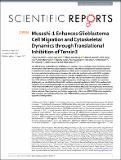| dc.contributor.author | Chen, Hsiao-Yun | en_US |
| dc.contributor.author | Lin, Liang-Ting | en_US |
| dc.contributor.author | Wang, Mong-Lien | en_US |
| dc.contributor.author | Laurent, Benoit | en_US |
| dc.contributor.author | Hsu, Chih-Hung | en_US |
| dc.contributor.author | Pan, Chih-Ming | en_US |
| dc.contributor.author | Jiang, Wan-Ru | en_US |
| dc.contributor.author | Chen, Pau-Yuan | en_US |
| dc.contributor.author | Ma, Hsin-I | en_US |
| dc.contributor.author | Chen, Yi-Wei | en_US |
| dc.contributor.author | Huang, Pin-I | en_US |
| dc.contributor.author | Chiou, Arthur | en_US |
| dc.contributor.author | Chiou, Shih-Hwa | en_US |
| dc.date.accessioned | 2017-11-21T20:41:35Z | |
| dc.date.issued | 2017 | en_US |
| dc.identifier.citation | Chen, H., L. Lin, M. Wang, B. Laurent, C. Hsu, C. Pan, W. Jiang, et al. 2017. “Musashi-1 Enhances Glioblastoma Cell Migration and Cytoskeletal Dynamics through Translational Inhibition of Tensin3.” Scientific Reports 7 (1): 8710. doi:10.1038/s41598-017-09504-7. http://dx.doi.org/10.1038/s41598-017-09504-7. | en |
| dc.identifier.issn | | en |
| dc.identifier.uri | http://nrs.harvard.edu/urn-3:HUL.InstRepos:34375101 | |
| dc.description.abstract | The RNA-binding protein Musashi-1 (MSI1) exerts essential roles in multiple cellular functions, such as maintenance of self-renewal and pluripotency of stem cells. MSI1 overexpression has been observed in several tumor tissues, including glioblastoma (GBM), and is considered as a well-established marker for tumor metastasis and recurrence. However, the molecular mechanisms by which MSI1 regulates cell migration are still undetermined. Here we reported that MSI1 alters cell morphology, promotes cell migration, and increases viscoelasticity of GBM cells. We also found that MSI1 directly binds to the 3′UTR of Tensin 3 (TNS3) mRNA, a negative regulator of cell migration, to inhibit its translation. Additionally, we identified that RhoA-GTP could be a potential regulator in MSI1/TNS3-mediated cell migration and morphological changes. In a xenograft animal model, high expression ratio of MSI1 to TNS3 enhanced GBM tumor migration. We also confirmed that MSI1 and TNS3 expressions are mutually exclusive in migratory tumor lesions, and GBM patients with MSI1high/TNS3low pattern tend to have poor clinical outcome. Taken together, our findings suggested a critical role of MSI1-TNS3 axis in regulating GBM migration and highlighted that the ratio of MSI1/TNS3 could predict metastatic and survival outcome of GBM patients. | en |
| dc.language.iso | en_US | en |
| dc.publisher | Nature Publishing Group UK | en |
| dc.relation.isversionof | doi:10.1038/s41598-017-09504-7 | en |
| dc.relation.hasversion | http://www.ncbi.nlm.nih.gov/pmc/articles/PMC5562834/pdf/ | en |
| dash.license | LAA | en_US |
| dc.title | Musashi-1 Enhances Glioblastoma Cell Migration and Cytoskeletal Dynamics through Translational Inhibition of Tensin3 | en |
| dc.type | Journal Article | en_US |
| dc.description.version | Version of Record | en |
| dc.relation.journal | Scientific Reports | en |
| dash.depositing.author | Laurent, Benoit | en_US |
| dc.date.available | 2017-11-21T20:41:35Z | |
| dc.identifier.doi | 10.1038/s41598-017-09504-7 | * |
| dash.authorsordered | false | |
| dash.contributor.affiliated | Hsu, Chih-Hung | |
| dash.contributor.affiliated | Laurent, Benoit | |


